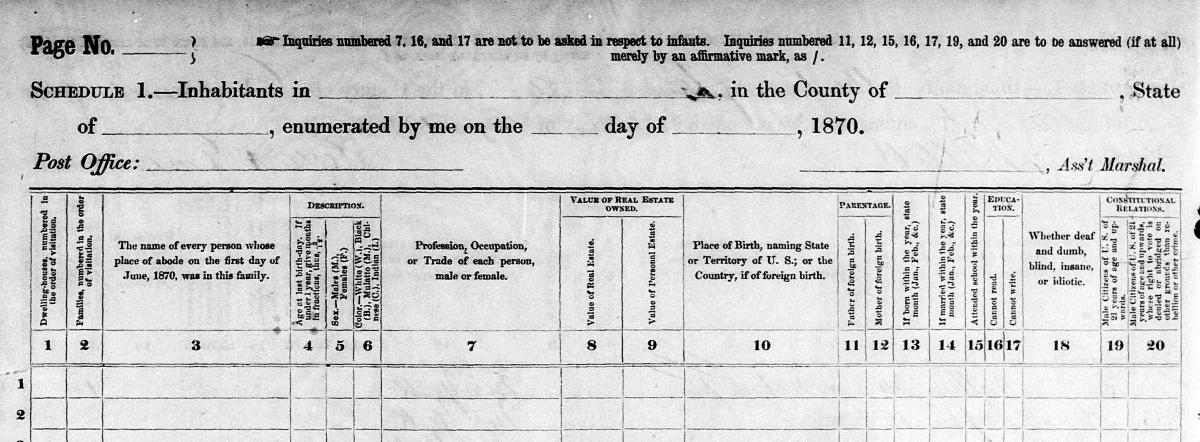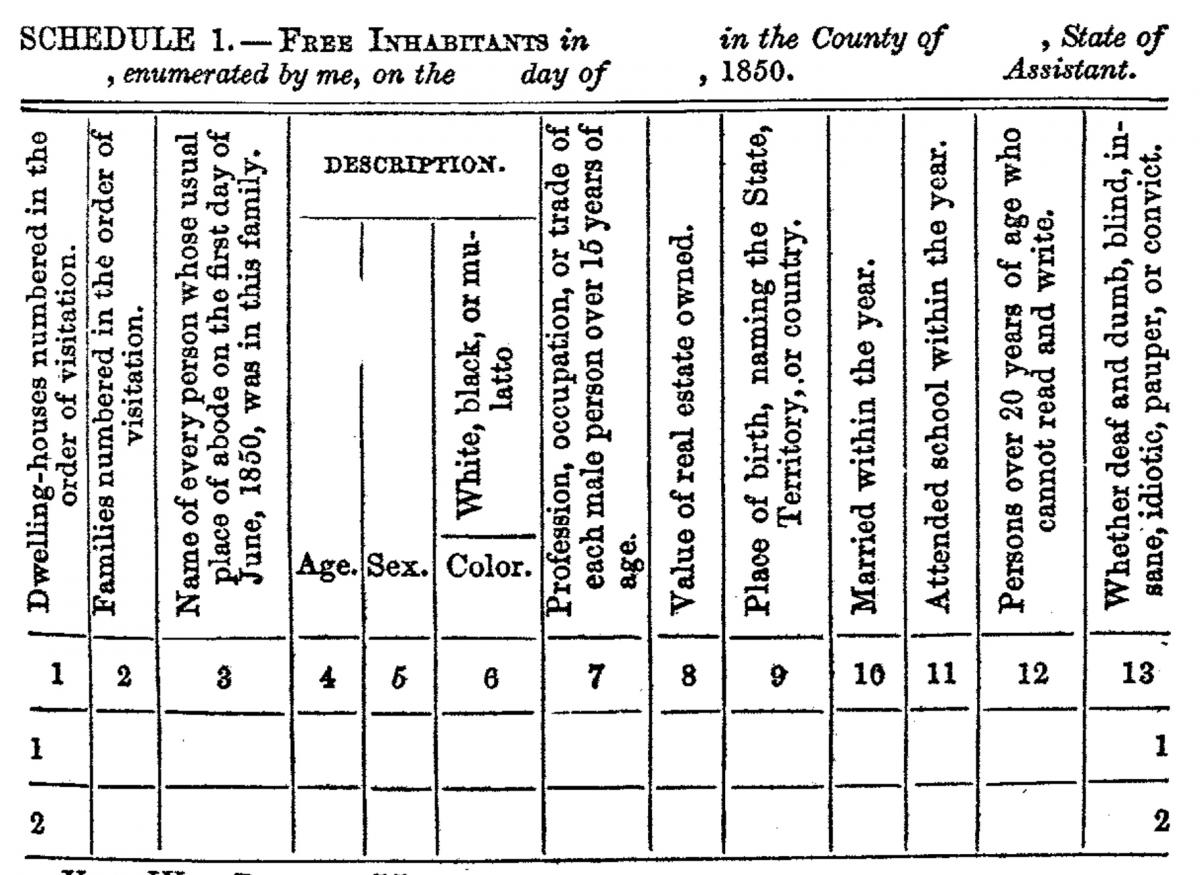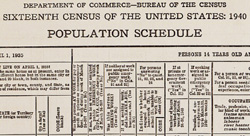
1870 Census Records
The 1870 population census was the Ninth Decennial Census of the United States. Taken every 10 years since 1790, census records provide a snapshot of the nation's population.
Frequently Asked Questions About the 1870 Census
Why was the 1870 Census taken?
Article I, Section 2, of the U.S. Constitution established that representation in the U.S. House of Representatives was based on population determined by a census taken at 10-year intervals: "The actual Enumeration shall be made within three Years after the first Meeting of the Congress of the United States, and within every subsequent Term of ten Years, in such Manner as they [Congress] shall by Law Direct."
What was the official census day?
Wednesday, June 1, 1870.
When was it taken?
The census began on Wednesday, June 1, 1870, and the completed census schedules were to be sent to the Census Office in Washington, DC, by September 10, 1870, under the rules and directions established 20 years earlier in an Act of Congress approved May 23, 1850 (“An Act providing for the taking of the seventh and subsequent Censuses of the United States....,” 9 Statutes at Large 428), as amended on May 6, 1870 ( 16 Statutes at Large 118), to cancel the slave schedule, which was obsolete due to the passage of the 13th Amendment to the U.S. Constitution. However, certain locations were enumerated a second time in 1870 or 1871 due to allegations of errors and undercounts in the original enumeration.
Who was counted?
The law required "all the inhabitants" of each Federal judicial district or territory be enumerated. The Instructions to Assistant Marshals explained that the term "place of abode" used in column 3 of Schedule 1 meant "the house or usual lodging place" and that a person "temporarily absent on journey or visit is to be counted as of the family...."
Who was involved?
- Secretaries of the Interior Jacob D. Cox (1869-70) and Columbus Delano (1870-75) had general supervision of census operations, tabulation, and reporting the results to the President and Congress.
- Superintendent of the Census Francis Amasa Walker (1870-72) directed the compilation of population data for Ninth Census, Volume 1, The Statistics of the Population of the United States.... (Washington: Government Printing Office, 1872) and A Compendium of the Ninth Census (Washington: Government Printing Office, 1872).
- The U.S. Marshal for each Federal judicial district was responsible for taking the census in his district with the help of assistant marshals whom he appointed. Each took an oath or affirmation that "I will to the best of my ability enumerate, or cause to be enumerated, all the inhabitants of said district ... and will faithfully perform all the duties enjoined on me...." Each assistant marshal took an oath or affirmation that "I will make a true and exact enumeration of all the inhabitants within the district assigned to me, ... and will make due and correct returns thereof..." The act also specified "That each assistant ... shall perform the service required of him, by a personal visit to each dwelling-house, and to each family...." After the information was entered on the forms, "such memoranda shall be immediately read to the person or persons furnishing the facts, to correct errors and supply omissions, if any shall exist."
- Every person over age 20 was required to cooperate: "That each and every free person more than twenty years of age, belonging to any family ..., and in case of the absence of the heads and other members of any such family, then any agent of such family shall be and each of them hereby is, required, if thereto requested by the marshal or his assistant, to render a true account, to the best of his or her knowledge, of every person belonging to such family ... on pain of forfeiting thirty dollars...."
What questions did the census ask?
- Schedule 1, Inhabitants, asked the questions listed below. The Assistant Marshal supplied answers to question 1 (dwelling house number), question 2 (family number), and probably in most cases to question 20 (vote denied or abridged).
- Dwelling houses, numbered in the order of visitation.
- Families, numbered in the order of visitation.
- Name of every person whose usual place of abode on the first day of June 1870, was in this family.
- Age at last birthday. If under 1 year, give months in fractions, thus, 3/12.
- Sex - Males (M), Females (F).
- Color - White (W), Black (B), Mulatto (M), Chinese (C), Indian (I).
- Profession, occupation, or trade of each person, male or female.
- Value of real estate owned.
- Value of personal estate owned.
- Place of Birth, naming the State or Territory of U.S., or the Country, if of foreign birth.
- Father of foreign birth [hash mark if yes]
- Mother of foreign birth [hash mark if yes]
- If born within the year, state month (Jan., Feb., etc.).
- If married within the year, state month (Jan., Feb., etc.).
- Attended school within the year [hash mark if yes]
- Cannot read [hash mark if yes]
- Cannot write [hash mark if yes]
- Whether deaf and dumb, blind, insane, idiotic, pauper, or convict [indicate disability]
- Male Citizens of U.S. of 21 years of age and upwards [hash mark if yes]
- Male Citizens of U.S. of 21 years of age and upwards, whose right to vote is denied or abridged on other grounds than rebellion or other crime.
Question 20 was created to fulfill the requirements of Section 2 of Amendment XIV of the U.S. Constitution, passed by Congress on June 13, 1866, and ratified on July 9, 1868. This section states that “...when the right to vote at any election for the choice of electors for President and Vice-President of the United States, Representatives in Congress, the Executive and Judicial officers of a State, or the members of the Legislature thereof, is denied to any of the male inhabitants of such State, being twenty-one years of age, and citizens of the United States, or in any way abridged, except for participation in rebellion, or other crime, the basis of representation therein shall be reduced in the proportion which the number of such male citizens shall bear to the whole number of male citizens twenty-one years of age in such State.”
Because the decennial census was used to determine the population of a state for the purpose of representation, it was necessary to add the question of whether an individual had been denied voting rights. The question was intended to determine the extent to which male former slaves were legally denied the right to vote. The Instructions to Assistant Marshals informed them that: "Many persons never try to vote, and therefore do not know whether their right to vote is or is not abridged. It is not only those whose votes have actually been challenged, and refused at the polls for some disability or want of qualification, who must be reported in this column; but all who come within the scope of any State law denying or abridging suffrage to any class or individual on any other ground than participation in rebellion or legal conviction of crime. Assistant Marshals, therefore, will be required carefully to study the laws of their own States in these respects and to satisfy themselves, in the case of each male citizen of the United States above the age of twenty-one years, whether he does or does not come within one of these classes." (Instructions, pp. 11-12).
What did the census form look like?
The Federal Government provided blank printed forms to the U.S. Marshals. There may be annotations such as certificates of oaths taken, population totals, and handwritten and mechanically stamped page numbers. On March 3, 1849, Congress delegated decisions about the questions to be asked on the census to the "Census Board" whose members were the Secretary of State, Attorney General, and Postmaster General. ("An Act to make Arrangements for taking the seventh Census," 9 Statutes at Large 402). Their decisions resulted in the form shown below.
What states and territories are included in the census?
Surviving population census records exist for Alabama, Arizona Territory, Arkansas, California, Colorado, Connecticut, Dakota Territory, Delaware, District of Columbia, Florida, Georgia, Idaho Territory, Illinois, Indiana, Iowa, Kansas, Kentucky, Louisiana, Maine, Maryland, Massachusetts, Michigan, Minnesota, Mississippi, Missouri, Montana Territory, Nebraska, Nevada, New Hampshire, New Jersey, New Mexico, New York, North Carolina, Ohio, Oregon, Pennsylvania, Rhode Island, South Carolina, Tennessee, Texas, Utah, Vermont, Virginia, Washington, West Virginia, Wisconsin, and Wyoming Territory. Special notes:
- Indian Territory (subsequently Oklahoma): No census taken.
- Some locations had two federal enumerations. In some cases, both enumerations are extant and included in National Archives Microfilm Publication M593, Ninth Census of the United States, 1870, and in other cases only the 2nd enumeration exists, as indicated below.
- Indiana: Indianapolis - federal (Summer 1870) and city (February 1871) "verified" as federal census in April 1871.
- Kansas: Junction City (Davis County) - 2nd enumeration only (December 1870).
- Missouri: St. Joseph City - 2nd enumeration only for 3rd, 4th, and 5th wards (January 1871). All other wards had their 1st and only enumeration in the Summer 1870.
- New York: New York County - 1st (Summer 1870) and 2nd (January 1871) enumerations.
- Ohio: Geauga County - 1st (Summer 1870) and 2nd (March 1871) enumerations.
- Ohio: Benton, Carroll, Clay, and Harris Townships (Ottawa County) - includes the 1st enumeration (Summer 1870) plus "Supplemental Returns" (pages) dated March 1871 for additional persons counted during the 2nd enumeration.
- Pennsylvania: Philadelphia - 1st (June 1870) and 2nd (November 1870) enumerations.
Are some 1870 census records missing?
Yes. The "federal copy" of the population census schedules were destroyed for Minnesota counties alphabetically from Aitkin through Sibley, but the "state copy" survived for all counties and is located at the Minnesota Historical Societies. All surviving Minnesota "federal" and "state" census schedules have been microfilmed and are digitally available as indicated below.
Where can I see the original 1870 census schedules?
Digital images are online:
- National Archives Microfilm Publication M593, Ninth Census of the United States, 1870 (1,009 rolls), is on popular genealogy websites, including Ancestry.com, FamilySearch.org, and others. The Minnesota counties included in M593 are Stearns, Steele, Stevens, St. Louis, Todd, Wabasha, Wadena, Waseca, Washington, Watonwan, Wilken, Winona, and Wright.
- National Archives Microfilm Publication T132, Minnesota Census Schedules for 1870 (13 rolls), contains the "state copy" of the census for all counties and is online at popular genealogy websites, including Ancestry.com, FamilySearch.org, and others.
Sources for More Information
More information about 1870 census recounts can be found in the following sources:
- Barrows, Robert G. "The Ninth Federal Census of Indianapolis: A Case Study in Civic Chauvinism." Indiana Magazine of History, Vol. 73, No. 1 (March 1977), pp. 1-16. Individuals may obtain access to the article by creating a free individual JSTOR account or through a participating library.
- Weintraub, Joel. "A Guide to the 1870 Census 2nd Counts, Part I" (video).
- Weintraub, Joel. "1870 Census 2nd Counts, Part 2, Philadelphia Recount Reasons, Logistics, [and] Census Items" (video).
- Weintraub, Joel. "1870 Census 2nd Count, Part 3, Philadelphia Finder Aids, Census Films, [and] Street Lists" (video).



